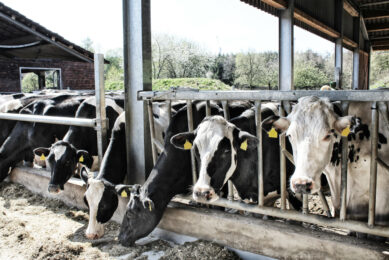First facility with respiration stalls to reduce methane in US

Thanks to partnerships with industry, government and New York farmers, Cornell’s Department of Animal Science is now home to new, state-of-the-art animal respiration stalls that will enable research on livestock feed, health and climate impacts. The facility is the first of its kind to be installed in the US.
Cornell researchers and administrators celebrated the facility with a ribbon-cutting ceremony on 18 April alongside partners from Cargill, the Genesee Valley Regional Market Authority, Balchem Corporation and the New York State Department of Agriculture and Markets.
“This facility typifies our Land Grant mission by creating a novel, transdisciplinary meeting-grounds where researchers and community partners can work together to solve major challenges,” said Benjamin Houlton, the Ronald P. Lynch Dean of Cornell’s College of Agriculture and Life Sciences. “These animal respiration measurements will accelerate livestock innovations for sustainability, both locally and around the world, and we’re so grateful to our New York state and industry partners for their continued support of this important project.”
Climate-controlled chambers
The new Cornell University animal respiration chambers are individual, climate-controlled rooms made of stainless steel with glass windows. Researchers will use the new facilities to understand how much greenhouse gas livestock produce and what management techniques could reduce those climate-warming gases.
Livestock emit methane, which is the second-largest contributor to global warming, after carbon dioxide. Among other things, researchers will test changes in livestock diets with the goal of optimising nutrition for efficient milk and meat production, enhanced animal health and minimum greenhouse gas production. Joseph McFadden, associate professor of animal science, spearheaded the effort to install the facility.
The animal respiration facility was funded in part by a capital grant from the New York State Department of Agriculture and Markets, and deputy commissioner Elizabeth Wolters attended the ribbon-cutting. Commissioner Richard Ball praised the cooperative partnership that made the facility possible.
“New York state is proud to have a nation-leading climate agenda, and as part of that we’re committed to assisting our farmers as they work to reduce methane emissions on their farms,” Ball said.
Animal diet changes
“Cornell’s new respiration chambers are going to be a critical piece of that effort, enabling researchers to conduct state-of-the-art experiments in highly controlled environments to understand how animals respond to diet changes. The results from this work will help our agricultural community better understand how to care for their animals while still ensuring that they can produce the local, nutritious foods that our communities rely on,” Ball added.
The Genesee Valley Regional Market Authority (GVRMA), a New York state public authority that serves farmers in 9 counties in western New York, was an early supporter of the new facility. Dairy farmers care deeply about providing nutritious food for their communities and about protecting the environment for future generations, said Brendan Tydings, administrator of the GVRMA. The industry group U.S. Dairy has set a goal for the national dairy community’s carbon footprint to be net zero by 2050.
“Everyone realises the importance of this, but how do you carry it out and get it done? That’s why the types of studies Professor McFadden will be doing in this new facility are so important, to provide substance to these somewhat lofty goals, to show where we need to prioritise our time and energy to make it realistic,” Tydings said. “This is going to provide a resource for our dairy farmers to test and to evaluate what they’re doing going forward so they can continue to improve.”
Join 13,000+ subscribers
Subscribe to our newsletter to stay updated about all the need-to-know content in the dairy sector, two times a week.










